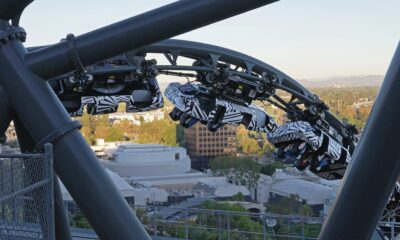Science
Blue Origin Advances Lunar Exploration Amid Artemis 3 Uncertainty

Blue Origin is making significant strides in its lunar exploration efforts, despite uncertainties surrounding NASA’s Artemis 3 mission. The company showcased its plans and progress during a recent panel at the American Astronautical Society’s 2025 von Braun Space Exploration Symposium. In addition to discussing their cargo and crewed lander developments, Blue Origin is also adapting to potential changes in contract arrangements for the Artemis missions.
During the symposium, Jacqueline Cortese, Blue Origin’s Senior Director of Civil Space, highlighted the upcoming uncrewed flight of the Blue Moon Mk. 1 lunar lander. This mission is set to be a pivotal moment for the company, taking place as soon as later this year. The lander, measuring 8.1 meters tall, is currently undergoing final assembly at a dedicated facility in Port Canaveral, Florida. Cortese emphasized that this mission is part of a broader effort to establish a sustainable human presence on the Moon.
The Blue Moon Mk. 1 is designed to be launched on Blue Origin’s New Glenn rocket, while its larger counterpart, the Blue Moon Mk. 2, will necessitate orbital refueling. Both landers are powered by the BE-7 engines, which are being tested in various locations across the United States. Dave Limp, Blue Origin’s CEO, recently shared an extensive video of a hot fire test that simulates a critical phase of the mission.
Cortese further elaborated on the specifics of the Mk. 1 mission, stating, “Once it is stacked in its finished configuration, we will be barging it over to NASA Johnson Space Center Chamber A to do a full thermal vacuum campaign.” This milestone is crucial as it prepares the lander for its upcoming mission.
The Mk. 1 will carry NASA’s SCALPSS (Stereo Cameras for Lunar-Plume Surface Studies) and LRA (Laser Retroreflective Array) payloads. These instruments will gather valuable data on lunar dust and crater formation during landing. Although a launch date has not been firmly established, Cortese hinted that it could occur in the next few weeks.
In addition to the Mk. 1, Blue Origin is also focused on developing the Mk. 2 lander for the Artemis 5 mission, scheduled for 2029. NASA awarded Blue Origin a contract worth $3.4 billion for this purpose. The Artemis 5 mission requires at least one uncrewed landing demonstration of the Mk. 2 before it can be utilized for astronaut missions.
As the debate surrounding Artemis 3 unfolds, NASA is reopening the contract for this mission due to delays in SpaceX’s work on its Human Landing System (HLS). NASA Acting Administrator Sean Duffy expressed the urgency to continue progress towards lunar exploration, stating, “The President and I want to get to the Moon in this President’s term.” This competitive environment presents an opportunity for Blue Origin as it seeks to accelerate its lunar plans.
Cortese noted the company’s commitment to advancing their cryogenic capabilities for in-space propellant transfer operations, a crucial aspect for the Mk. 2 lander. Recent testing at NASA’s Marshall Space Flight Center has focused on the Blue Origin Utility Transfer Mechanism, which will support these operations.
As Blue Origin continues to prepare its lunar vehicles, it faces the dual challenge of ensuring safety for crewed missions while meeting NASA’s ambitious timelines. The developments surrounding Artemis 3, a mission intended to mark the first human landing on the Moon since 1972, have created a complex landscape for companies involved in lunar exploration.
With the Artemis 3 launch currently projected for mid-2027, uncertainties persist. As Cortese stated, “We have what we think are some good ideas about maybe a more incremental approach that could be taken advantage of for an acceleration-type scenario.” This approach reflects an adaptive strategy that could position Blue Origin favorably in the evolving landscape of space exploration.
In summary, Blue Origin is actively advancing its lunar exploration missions, with a focus on developing both cargo and crewed landers. The company’s recent progress highlights its commitment to establishing a sustainable human presence on the Moon, even as it navigates the challenges posed by shifting contractual dynamics and competition in the space industry.
-

 World2 weeks ago
World2 weeks agoGlobal Air Forces Ranked by Annual Defense Budgets in 2025
-

 World2 weeks ago
World2 weeks agoMass Production of F-35 Fighter Jet Drives Down Costs
-

 Top Stories2 weeks ago
Top Stories2 weeks agoNew ‘Star Trek: Voyager’ Game Demo Released, Players Test Limits
-

 Top Stories2 weeks ago
Top Stories2 weeks agoDirecTV to Launch AI-Driven Ads with User Likenesses in 2026
-

 Science2 weeks ago
Science2 weeks agoTime Crystals Revolutionize Quantum Computing Potential
-

 World2 weeks ago
World2 weeks agoElectrification Challenges Demand Advanced Multiphysics Modeling
-

 Lifestyle2 weeks ago
Lifestyle2 weeks agoLia Thomas Honored with ‘Voice of Inspiration’ Award at Dodgers Event
-

 Entertainment2 weeks ago
Entertainment2 weeks agoFreeport Art Gallery Transforms Waste into Creative Masterpieces
-

 Lifestyle2 weeks ago
Lifestyle2 weeks agoDiscover Reese Witherspoon’s Chic Dining Room Style for Under $25
-

 Health2 weeks ago
Health2 weeks agoGavin Newsom Critiques Trump’s Health and National Guard Plans
-

 Entertainment2 weeks ago
Entertainment2 weeks agoFast & Furious Coaster Hits the Track at Universal Studios
-

 Health2 weeks ago
Health2 weeks agoResearchers Uncover New Insights into Cancer Mortality Causes









